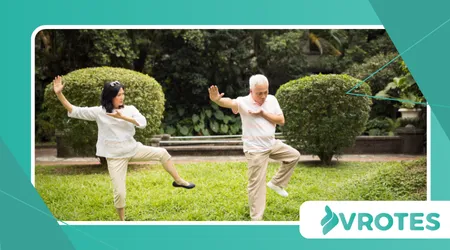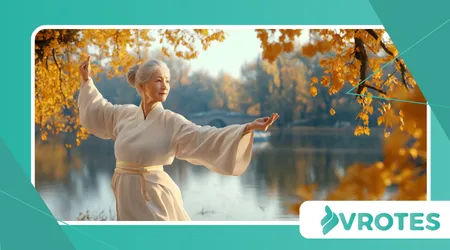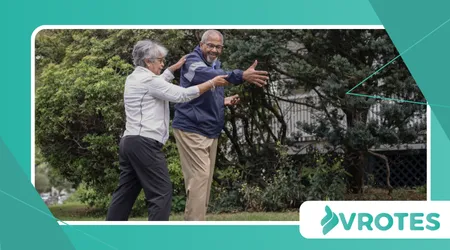How Tai Chi Improves Proprioception in Older Adults

Tai Chi Improves Proprioception in Older Adults. The conversation around healthy aging is constantly evolving, focusing increasingly on holistic methods that seamlessly integrate mind and body.
Anúncios
The ancient Chinese practice of Tai Chi has emerged as a cornerstone in this dialogue, offering profound benefits, particularly when it comes to spatial awareness.
For older adults seeking a gentle yet powerful way to enhance their physical stability, understanding Tai Chi Improves Proprioception in Older Adults is essential.
This subtle, internal sense—proprioception—is the body’s hidden navigational system, and its cultivation is key to maintaining independence and reducing fall risk in later years.
What is Proprioception and Why Does it Decline with Age?
Proprioception is the unconscious perception of movement and spatial orientation, essentially telling you where your body parts are relative to one another without needing visual confirmation.
Anúncios
Imagine closing your eyes and still knowing the exact position of your hand; that’s proprioception at work.
This sensory feedback loop relies on mechanoreceptors in your muscles, tendons, and joints. As we age, these receptors become less sensitive, a phenomenon called sensory decline.
This reduced sensitivity slows reaction time and diminishes the accuracy of position sensing, which drastically elevates the risk of trips and falls, transforming everyday actions into precarious maneuvers.
How Does Tai Chi Act as a Proprioceptive Trainer? Tai Chi Improves Proprioception in Older Adults
Tai Chi is often described as “meditation in motion.” Its practice involves a sequence of slow, continuous, and deliberate movements, coupled with deep, regulated breathing.
This method forces a high level of conscious attention to the body’s shifting center of gravity and the precise positioning of the limbs.
Read more: The Link Between Breath Retention and Cellular Oxygen Use
The movements are performed through a large range of motion, often requiring single-leg stance or subtle weight transfers, which fundamentally challenges the proprioceptive system.
This consistent, low-impact sensory engagement acts as a retraining mechanism for the nervous system.
Consider the movement “Parting the Wild Horse’s Mane.” The practitioner shifts their weight slowly, maintaining balance on one leg while the opposing arm floats outward.
This demands extraordinary sensory processing. The body must constantly calculate joint angles, muscle tension, and weight distribution.
This continuous, mindful adjustment is the heart of why Tai Chi Improves Proprioception in Older Adults.
It’s an internal calibration process, a constant conversation between the brain and the body’s position sensors.

What Evidence Supports Tai Chi’s Impact on Body Awareness?
Scientific validation firmly supports Tai Chi’s role in enhancing body awareness. Numerous studies have focused on specific joints, as they are central to balance.
See how interesting: Why Qi Gong Improves Joint Health Beyond Flexibility
A systematic review published in Frontiers in Aging Neuroscience in 2022 highlighted that long-term Tai Chi practice significantly enhanced balance control in older adults, specifically by improving the efficiency of sensory reweighting—the body’s ability to prioritize proprioceptive input over visual or vestibular cues when needed.
This is critical for preventing falls in low-light or uneven terrain situations.
Consider this data on ankle joint position sense (JPS), a key measure of proprioception:
| Group | Average Ankle JPS Error (Degrees) |
| Older Adults (Control) | 4.0 |
| Older Adults (Tai Chi Practitioners) | 2.1 |
A lower JPS error indicates superior proprioceptive acuity. Tai Chi Improves Proprioception in Older Adults by reducing this error, suggesting a more accurate sense of where the ankle is in space, which is a powerful defense against ankle sprains and stumbles.
Why is Enhanced Proprioception Important for Fall Prevention?
Falls are not a benign part of aging; they represent the leading cause of injury-related death among older adults.
Annually, around 29 million falls occur in the U.S., resulting in over 37,000 deaths. This statistic underscores the urgency of effective prevention strategies.
Enhanced proprioception directly translates to improved reactive balance.
++ How Menopause Impacts Your Circadian Rhythm
When a slight perturbation, like a rug edge or an unexpected bump, occurs, the person with better proprioception can detect the shift faster and initiate a corrective muscle response more accurately.
Think of proprioception as the radar system of a ship navigating rough seas.
A ship with a fully functioning, finely tuned radar (enhanced proprioception) anticipates changes and corrects course smoothly.
A ship with a degraded radar (age-related decline) is slow to react and more likely to capsize.
Tai Chi sharpens that radar, allowing for quicker, more nuanced adjustments to maintain upright posture.

How Can Older Adults Integrate Tai Chi into Their Routine?
Integrating Tai Chi does not require years of martial arts training.
Beginners can start with simple, short forms focusing purely on weight shifting and mindful posture.
An example is practicing the “Golden Rooster Stands on One Leg” movement while holding onto a stable chair.
This simple, controlled action immediately challenges proprioceptive limits in a safe environment, building confidence and neurological connection.
Another exercise is the “Clock Sweep,” where a person stands still and, with a subtle hip rotation, visually follows a spot on the floor in a circular motion, integrating head, trunk, and lower limb awareness.
This practice reinforces the brain-body connection in a way that static exercises simply cannot match.
Tai Chi Improves Proprioception in Older Adults through consistency, not intensity.
Will the widespread adoption of such accessible mind-body practices finally shift the paradigm of age-related disability?
Tai Chi Improves Proprioception in Older Adults
The pursuit of graceful aging is fundamentally a commitment to maintaining a robust connection with one’s own body.
Tai Chi Improves Proprioception in Older Adults by offering a low-impact, deeply engaging practice that systematically enhances this crucial internal sense.
By slowing down and paying attention, practitioners effectively rewire their neural pathways for better balance, reducing the specter of falls, and supporting a truly independent lifestyle.
For anyone looking to invest in their future stability, the fluid movements of Tai Chi offer a sustainable, evidence-based path.
Frequently Asked Questions
Is Tai Chi safe for older adults with existing balance problems?
Yes. Tai Chi is considered a low-impact exercise and is generally very safe.
Most movements are performed slowly, often with the option to hold onto a chair or wall for stability, making it suitable even for individuals with moderate balance issues.
Always consult a physician before starting any new exercise program.
How long does it take to see an improvement in proprioception from practicing Tai Chi?
While some subjective improvements in body awareness may be felt within a few weeks, studies suggest that significant, measurable improvements in proprioception and balance typically require 8 to 12weeks of consistent practice (at least two to three times per week).
What style of Tai Chi is best for proprioception and fall prevention?
Many studies have focused on the Yang style, due to its widespread availability and smooth, large movements.
However, any style that emphasizes slow, continuous movement, mindful weight transfer, and posture alignment will be beneficial for enhancing proprioception.
Can I practice Tai Chi on my own, or do I need an instructor?
While learning the basics from a certified instructor is highly recommended to ensure correct form and avoid developing poor habits, many benefits can be sustained through consistent, self-guided practice once the fundamental principles of weight shifting and alignment are understood.
++ performance in healthy older adults
++ The effects of Tai Chi on standing balance control in older adults
